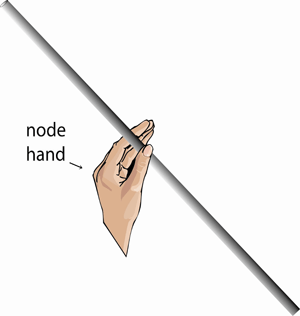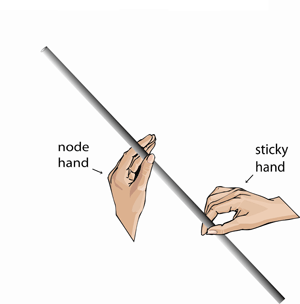Singing Rod
Concerto No. 1 for the Singing Rod in Al# major

A rare snapshot of the Physics Fairy performing the singing rod. Photo Credit: Keith Warren
While everyone knows that the world needs more cowbell, it is a little known fact that an aluminum rod can sing to your heart’s content.
What you Need
- ¼” Aluminum rod from the hardware store that is about 2 feet or longer
- Violin or cello rosin
What to Do
Legend has it that the song of the singing rod summons the Physics Fairy. She has been known to guide kids like you through physics problems and experiments. It is thought that the physics fairy inspired a young patent clerk in 1905 to imagine what it would be like to ride on a beam of light. He then developed a very special theory that changed the world of physics. If you aspire to greatness, then keep reading and learn to play the singing rod.
To begin, you will need to find the middle of the rod by balancing it across your finger. Pinch the rod at that middle point and hold it up into the air like a fairy wand. Let’s call this your node hand. As you will see later, your fingers will be pinching the nose; I mean the node of the rod. You may use either hand depending on whether you are left handed or other handed. Much like playing the violin, the manner in which you hold the rod is very important.

Now rest the end of the rod on your foot for stability and rub the rosin up and down along half of the rod. *Caution: Do not eat the rosin* You may also want to rub rosin directly on the pointer finger and thumb of your other hand. We will appropriately call this your sticky hand.

Once the rod is sufficiently sticky, you are ready to play. While pinching the node of the rod with your node hand, firmly rub along the sticky end of the rod with your sticky hand. Continue to rub repeatedly in one direction. Vary the speed and pressure of each stroke until you hear the rod sing. As with any musical instrument, this will take some practice. Someday you could be the first to play Bach’s Concerto No. 1 for the Singing Rod in C# BWV 1065.5 at Carnegie Hall!
What’s Going On?
Stroking the rod with sticky fingers creates longitudinal vibrations in the rod. Longitudinal vibrations are waves that travel along the length of the rod. The waves travel to the end of the rod in which they transmit vibrations to the surrounding air molecules. Longitudinal vibrations of air molecules are then interpreted by your ears as sound. However, that is only part of the story. Some of the vibrations traveling toward the end of the aluminum rod are reflected. The reflected waves return and head back in the opposite direction toward your fingers. On their way back, they collide in a head on collision with similar waves created by your sticky fingers!

Now don’t worry, a wave collision is not quite a massacre. Waves can either interfere constructively or destructively depending on how they meet. The points on rod where the waves interfere destructively are called nodes. Waves at the nodes cancel each other out. Hence there are no vibrations at the nodes. Then where is the rod vibrating? Naturally, the points where the rod is vibrating are called the antinodes. Waves at the antinodes meet constructively and add up to create bigger waves.
When you pinch the rod in the center, you restrain it from vibrating. This creates a node at that point. If you rub the rod slowly, you will produce waves of a relatively low pitch. These waves will create an antinode at the end of the rod. This pitch is called the natural frequency of your rod. Long rods will have a lower natural frequency than short rods. You should try both sizes.
Now to go beyond the natural frequency, you will rub the rod more aggressively. This will create a higher pitch sound that your parents might describe as shrieking or just plain unpleasant. These vibrations are called harmonics.
Try This!
Another clever way of finding the center of the rod is to place it over the ends of your pointer fingers. Now slowly bring your arms together while allowing your fingers to slide beneath the rod. The pressure of the rod on each finger will adjust the amount of sliding friction so that your fingers will automatically come together at the center of mass of the rod. Since the rod is uniform in shape, the center of mass is also the geometric center.
The shower in your bathroom and the stairwell of a building has the perfect acoustics for many physics experiments. When you sing in the shower, the waves reflect off of the walls. At certain pitches, the waves will constructively interfere and produce a phenomenon called resonance. Try singing high and low until you find the resonant frequency of your shower. You will know it when you hear it, because resonance will have you thinking that you are an opera star.
More Information











